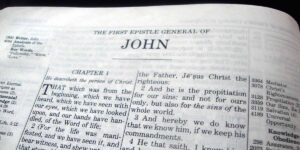The Gospel of John has the clearest statement of purpose in the Bible: “But these are written that you may believe that Jesus is the Christ, the Son of God, and that believeth you may have life in His name” (20:31). John selected the signs he used for the specific purpose of creating intellectual (“that you may believe”) and spiritual (“that believing you may have eternal life”) conviction about the Son of God.
John makes it clear that Jesus is not just a man; he is the eternal Son of God. He is the light of the world because he offers this gift of eternal life to all mankind. How blind and foolish to call Jesus nothing more than an unusually good man or moral teacher. Yet we sometimes act as if this were true when we casually toss around his words and go about living our own way. If Jesus is the eternal Son of God, we should pay attention to his divine identity and life-giving message.
Jesus meets with individuals, preaches to great crowds, trains his disciples, and debates with the religious leaders. The message that he is the Son of God receives a mixed reaction. Some worship him, some are puzzled, some shrink back, and some move to silence him. We see the same varied reactions today. Times have changed, but people’s hearts remain hard. May we see ourselves in these encounters Jesus had with people, and may our response be to worship and follow him.
Jesus carefully instructed the disciples on how to continue to believe even after his death, yet they could not take it in. After he died and the first reports came back that Jesus was alive, the disciples could not believe it. Thomas is especially remembered as one who refused to believe even when he heard the eyewitness accounts from other disciples. May we not be like Thomas, demanding a physical face-to-face encounter, but may we accept the eyewitness testimony of the disciples that John has recorded in this Gospel.
Writer of the Gospel of John
The title says that the Gospel was written by John, and other evidence identifies this John as the son of Zebedee. The internal evidence indicates that the author was (1) an apostle (1:14; cf. 2:11; 19:35), (2) one of the 12 disciples (“the disciple whom Jesus loved”; 13:23; 19:26; 20:2; 21:20; cf. 21:24-25), and, still more specifically, (3) John the son of Zebedee (note the association of “the disciple whom Jesus loved” with Peter in 13:23-24; Acts 1:13; 3:1-4:37; 8:14-25; Galatians 2:9). The external evidence from the church fathers supports this identification.
Date Written
Uncertain. Probably in the late first century, 85 to 90 A.D. There is evidence that this gospel could have been written earlier.
My belief and the lesser of modern scholars is that all the books of the Bible were written before A.D. 70 (the destruction of the temple). The destruction of the temple marks the end of the Old Testament (covenant). All the prophetic books would have been written before this time.
To Whom Written
The Gospel of John was written by the apostle John, the son of Zebedee, a Palestinian Jew and a member of Jesus’ inner apostolic circle during his earthly ministry. John’s original audience consisted of both Jews and Gentiles living in the larger Greco-Roman world in Ephesus and beyond toward the close of the first century A.D. He frequently explains Jewish customs and Palestinian geography and translates Aramaic terms into Greek, thus showing an awareness of Non-Jewish readers. He also presents Jesus as the Word become flesh against the backdrop of Greek thought that included Stoicism and early Gnosticism. But John also shows awareness of Jewish readers as he demonstrates Jesus to be the Jewish Messiah, the fulfillment of many Old Testament themes, and the Son of God who was sent by God the Father to reveal the only true God and to provide redemption for humanity.
The purpose statement in 20:30-31 makes it appear that John wrote with an evangelistic intent. However, his depth of teaching shows that he wanted readers not only to come to initial saving faith in Jesus but also to grow into a rich, well-informed faith. John’s central contention is that Jesus is the long-awaited Messiah and Son of God and that by believing in him people may have eternal life. To this end, he marshals the evidence of several selected messianic signs performed by Jesus and of a series of witnesses to Jesus – including the Scriptures, John the Baptist. Jesus himself, God the Father, Jesus’ works, the Spirit, and John himself. It is also likely that John sought to present Jesus as the new temple and center of worship for God’s people, a concept that would be especially forceful if the date of composition (as seems likely) was subsequent to A.D. 70 (the time of the destruction of the Jerusalem temple).
Purpose of the Gospel of John
To inspire faith in Jesus Christ as the Son of God and that all who believe in Him will have eternal life. The key verse in this gospel is John 20:31, ” But these are written, that ye might believe that Jesus is the Christ, the Son of God; and that believing ye might have life through his name.” John is the only book in the Bible that actually comes with a stated purpose!!
Theological Contribution of the Gospel of John
John writes with a modest vocabulary, but his words are charged with symbolism. Terms like believe, love, truth, world, light, and darkness, above and below, name, witness, sin, judgment, (eternal) life, glory, bread, water, and hour are the keywords if the gospel. In John 3:16-21, a passage of fewer than 150 words in Greek, seven of these terms occur.
The world is where God reveals truth (8:32), light (8:12), and life (14:6) in His Son Jesus Christ. The world is also where persons must decide for or against the witness of Christ, and the decision is judgment (3:18). Sin is to misjudge Jesus – fail to receive Him as the bread of life (6:35), or not walk in Him as the light of the world (8:12). The Son has come from above to glorify the Father (17:1), and He does so in His “hour” (12:23; 13:1) – through His suffering on the cross.
In the synoptic gospels – Matthew, Mark, and Luke – Jesus utters short sayings. Longer discourses, such as the Sermon on the Mount (Matthew 5-7), are either collections of sayings on various themes or, like Matthew 13, mostly parables.
John, on the other hand, records no parables and few of the brief sayings so common to the Synoptics. Rather, he expands upon an incident, for example, Nicodemus (chapter 3); or he takes up an image, for example, light (chapter 8). These discourses are blended so completely with John’s own style that frequently the reader cannot tell whether it is John or Jesus speaking (3:16).
The Gospel of John expresses the uniqueness of the Son’s relationship with the Father. John begins with the preexistence of Jesus: “In the beginning was the Word” (1:1). Jesus is divine (“the Word was God,” 1:1), but He is also human (“the Word became flesh,” 1:14).
He also introduces Jesus by seven key titles: Word, Lamb of God, Rabbi, Messiah, King of Israel, Son of God, and Son of Man. Only in John do we find the “I am” sayings: “I am the bread of life” (6:35), “I am the light of the world” (8:12), “before Abraham was , I AM” (8:58), “I am the door of the sheep” (10:7), “I am the good shepherd” (10:11), “I and My Father are one” (10:30), “I am the way, the truth, and the life” (14:6), and “I am the vine” (15:5). In each of these sayings the “I” identifies Jesus with the name of God, “I AM” (Exodus 3:14).
Special Consideration in the Gospel of John
Our present Gospel of John contains a story that probably was not written by the original author. The account of the woman caught in adultery (7:53 – 8:11) differs markedly in style from the rest of John. It is not found in the earlier and better manuscripts of the book, although there is no reason to doubt that it portrays an actual event in Jesus’ ministry.
Recommended Bible Study Resources
ESV Study Bible – Study Bibles give you a deeper understanding of God’s Word with tools for life application like commentary, maps, charts, concordance, and study notes. Search our popular translations- NIV, ESV, NKJV, KJV and more!
Believer’s Bible Commentary: Second Edition – A Bible commentary is a written, systematic series of explanations and interpretations of Scripture. Commentaries often analyze or expound on individual books of the Bible, chapter by chapter and verse by verse. Some commentary works provide analysis of the whole of Scripture.
The New Strong’s Expanded Exhaustive Concordance of the Bible – The best concordance for word study! This exclusive new edition of a legendary classic puts generations of biblical research at your fingertips. A valuable tool for pastors, teachers, and students of the Bible.
Vine’s Complete Expository Dictionary of Old and New Testament Words – This classic word study resource allows you to study the meaning of biblical words in the original languages without spending years learning Greek or Hebrew. A great resource for students, seasoned pastors, and anyone who enjoys biblical word studies–even if they have little to no formal training in Hebrew or Greek.
Halley’s Bible Handbook – The beloved and classic Bible companion has been thoroughly updated, while retaining its time-honored features and Dr. Halley’s highly personal style, to offer even greater clarity, insight, and usefulness.
Click here to view or print the Bible outline on the “Gospel of John – Written So That You May Believe“





